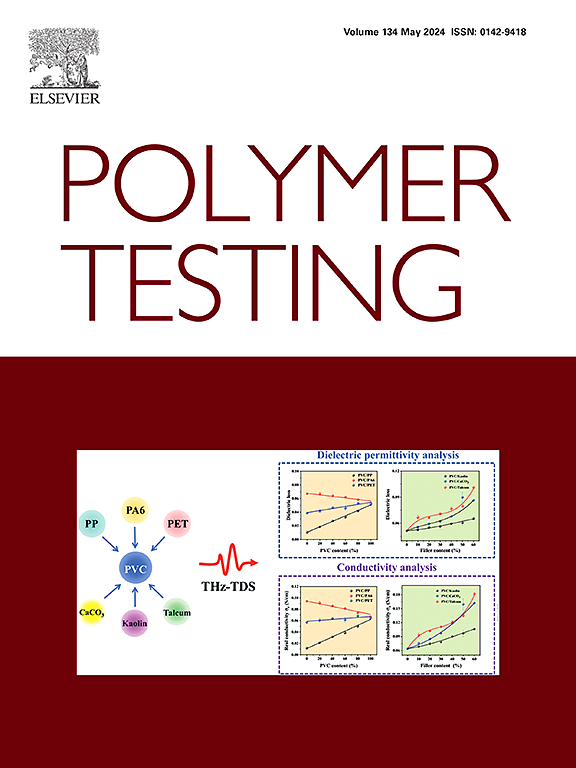PDMS弹性体轴向和剪切力学响应的测量及泊松比的数字图像相关测定
IF 5
2区 材料科学
Q1 MATERIALS SCIENCE, CHARACTERIZATION & TESTING
引用次数: 0
摘要
测量不同变形模式下的应力应变响应对建立软聚合物的本构模型具有重要意义。然而,由于在加载过程中产生不必要的应力集中导致过早失效,使用传统技术对柔软和柔性聚合物进行此类测量具有挑战性。在本研究中,采用非接触式数字图像相关(DIC)技术和一种新的实验装置来精确测量受有限应变作用的试样表面的应变场。在单轴压缩、单轴拉伸和10−3/s - 10−1/s的剪切速率范围内,研究了三种不同基料与硬化剂配比的聚二甲基硅氧烷(PDMS)弹性体在三种不同变形模式下的性能。所得的应变场在所有变形模式下均表现出均匀性,直至有限应变。低应变速率试验受应变加速度和惯性效应的影响最小,而在高应变速率(10−1/s)下加载的试样在加载过程中首先受到应变加速度的影响,这使得从应力-应变响应的初始斜率中可靠地确定杨氏模量和剪切模量成为可能。由轴向应变与侧向应变之比计算得到的泊松比在小应变下接近0.5,与由杨氏模量(E)与剪切模量(G)之比(E/G)计算得到的泊松比吻合较好,验证了线弹性理论在小应变下的正确性。所有组合物的切模量在稳定应变速率区域几乎不敏感。本文章由计算机程序翻译,如有差异,请以英文原文为准。
Measurement of axial and shear mechanical response of PDMS elastomers and determination of Poisson's ratio using digital image correlation
Measurement of stress-strain response under different deformation modes is important for developing constitutive models of soft polymers. However, such measurements on soft and compliant polymers are challenging using traditional techniques due to generation of unwanted stress concentrations leading to premature failure during loading. In this study, a non-contact digital image correlation (DIC) technique along with a novel experimental setup were used to accurately measure the strain field on a specimen surface subjected to finite strain. Polydimethylsiloxane (PDMS) elastomers of three different base polymer to hardener ratio were characterized under three different deformation modes— uniaxial compression, uniaxial tension, and simple shear—over strain rates ranging between 10−3/s–10−1/s. The resulting strain fields exhibited uniformity across all the deformation modes up to finite strains. While the lower strain rate experiments are minimally affected by strain acceleration and inertia effects, the specimens loaded under higher strain rate (10−1/s) are initially affected by strain acceleration during loading, which precluded reliable determination of Young's moduli and shear moduli from the initial slope of the stress-strain responses. The Poisson's ratio calculated from the ratio between measured axial and lateral strains was close to 0.5 at small strains, and exhibited a close match with that calculated from Young's modulus (E) to shear modulus (G) ratio (E/G), validating linear elasticity theory at small strains. The tangent moduli for all the compositions were found to be practically strain-rate insensitive in the region of steady strain rate.
求助全文
通过发布文献求助,成功后即可免费获取论文全文。
去求助
来源期刊

Polymer Testing
工程技术-材料科学:表征与测试
CiteScore
10.70
自引率
5.90%
发文量
328
审稿时长
44 days
期刊介绍:
Polymer Testing focuses on the testing, analysis and characterization of polymer materials, including both synthetic and natural or biobased polymers. Novel testing methods and the testing of novel polymeric materials in bulk, solution and dispersion is covered. In addition, we welcome the submission of the testing of polymeric materials for a wide range of applications and industrial products as well as nanoscale characterization.
The scope includes but is not limited to the following main topics:
Novel testing methods and Chemical analysis
• mechanical, thermal, electrical, chemical, imaging, spectroscopy, scattering and rheology
Physical properties and behaviour of novel polymer systems
• nanoscale properties, morphology, transport properties
Degradation and recycling of polymeric materials when combined with novel testing or characterization methods
• degradation, biodegradation, ageing and fire retardancy
Modelling and Simulation work will be only considered when it is linked to new or previously published experimental results.
 求助内容:
求助内容: 应助结果提醒方式:
应助结果提醒方式:


